Pumping Station Desing - Second Edition by Robert L. Sanks, George Tchobahoglous, Garr M. Jones
Подождите немного. Документ загружается.

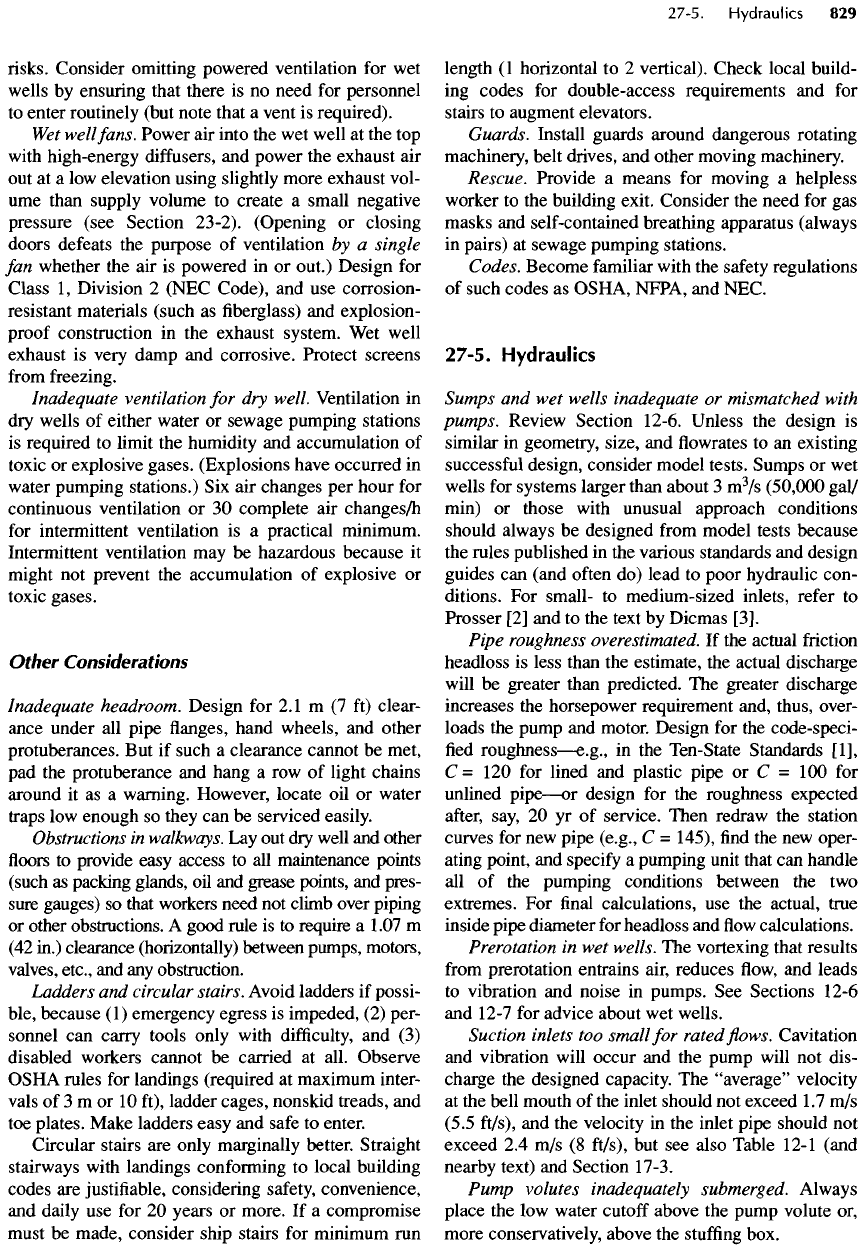
risks. Consider omitting powered ventilation
for wet
wells
by
ensuring that there
is no
need
for
personnel
to
enter routinely (but note that
a
vent
is
required).
Wet
well
fans. Power
air
into
the wet
well
at the top
with
high-energy
diffusers,
and
power
the
exhaust
air
out
at a low
elevation using slightly more exhaust vol-
ume
than supply volume
to
create
a
small negative
pressure (see Section
23-2).
(Opening
or
closing
doors defeats
the
purpose
of
ventilation
by a
single
fan
whether
the air is
powered
in or
out.) Design
for
Class
1,
Division
2
(NEC Code),
and use
corrosion-
resistant materials (such
as
fiberglass)
and
explosion-
proof construction
in the
exhaust system.
Wet
well
exhaust
is
very damp
and
corrosive. Protect
screens
from
freezing.
Inadequate
ventilation
for dry
well. Ventilation
in
dry
wells
of
either water
or
sewage pumping stations
is
required
to
limit
the
humidity
and
accumulation
of
toxic
or
explosive gases. (Explosions have occurred
in
water
pumping stations.)
Six air
changes
per
hour
for
continuous
ventilation
or 30
complete
air
changes/h
for
intermittent ventilation
is a
practical minimum.
Intermittent
ventilation
may be
hazardous because
it
might
not
prevent
the
accumulation
of
explosive
or
toxic
gases.
Other
Considerations
Inadequate
headroom. Design
for
2.1
m
(7 ft)
clear-
ance under
all
pipe
flanges,
hand wheels,
and
other
protuberances.
But if
such
a
clearance cannot
be
met,
pad the
protuberance
and
hang
a row of
light chains
around
it as a
warning. However, locate
oil or
water
traps
low
enough
so
they
can be
serviced easily.
Obstructions
in
walkways.
Lay out dry
well
and
other
floors
to
provide easy access
to all
maintenance points
(such
as
packing glands,
oil and
grease points,
and
pres-
sure
gauges)
so
that workers need
not
climb over piping
or
other obstructions.
A
good rule
is to
require
a
1.07
m
(42
in.) clearance (horizontally) between pumps, motors,
valves,
etc.,
and any
obstruction.
Ladders
and
circular stairs. Avoid ladders
if
possi-
ble, because
(1)
emergency egress
is
impeded,
(2)
per-
sonnel
can
carry tools only with
difficulty,
and (3)
disabled workers cannot
be
carried
at
all. Observe
OSHA rules
for
landings (required
at
maximum inter-
vals
of 3 m or 10
ft), ladder cages, nonskid treads,
and
toe
plates. Make ladders easy
and
safe
to
enter.
Circular stairs
are
only marginally better. Straight
stairways
with landings conforming
to
local building
codes
are
justifiable,
considering
safety,
convenience,
and
daily
use for 20
years
or
more.
If a
compromise
must
be
made, consider ship stairs
for
minimum
run
length
(1
horizontal
to 2
vertical). Check local build-
ing
codes
for
double-access requirements
and for
stairs
to
augment elevators.
Guards.
Install guards around dangerous rotating
machinery, belt drives,
and
other moving machinery.
Rescue. Provide
a
means
for
moving
a
helpless
worker
to the
building exit. Consider
the
need
for gas
masks
and
self-contained breathing apparatus (always
in
pairs)
at
sewage pumping stations.
Codes.
Become familiar with
the
safety
regulations
of
such codes
as
OSHA, NFPA,
and
NEC.
27-5.
Hydraulics
Sumps
and wet
wells inadequate
or
mismatched with
pumps. Review Section 12-6. Unless
the
design
is
similar
in
geometry, size,
and flowrates to an
existing
successful
design, consider model tests. Sumps
or wet
wells
for
systems larger than about
3
m
3
/s
(50,000
gal/
min)
or
those with unusual approach conditions
should
always
be
designed
from
model tests because
the
rules published
in the
various standards
and
design
guides
can
(and
often
do)
lead
to
poor hydraulic con-
ditions.
For
small-
to
medium-sized inlets, refer
to
Prosser
[2] and to the
text
by
Dicmas
[3].
Pipe
roughness overestimated.
If the
actual friction
headloss
is
less than
the
estimate,
the
actual discharge
will
be
greater than predicted.
The
greater discharge
increases
the
horsepower requirement and, thus, over-
loads
the
pump
and
motor. Design
for the
code-speci-
fied
roughness
—
e.g.,
in the
Ten-State Standards [1],
C=
120 for
lined
and
plastic pipe
or C = 100 for
unlined
pipe
—
or
design
for the
roughness expected
after,
say,
20 yr of
service. Then redraw
the
station
curves
for new
pipe (e.g.,
C =
145),
find the new
oper-
ating
point,
and
specify
a
pumping unit that
can
handle
all of the
pumping conditions between
the two
extremes.
For final
calculations,
use the
actual, true
inside pipe diameter
for
headloss
and flow
calculations.
Prerotation
in wet
wells.
The
vortexing
that results
from
prerotation entrains air, reduces
flow, and
leads
to
vibration
and
noise
in
pumps.
See
Sections 12-6
and
12-7
for
advice about
wet
wells.
Suction
inlets
too
small
for
rated
flows.
Cavitation
and
vibration will occur
and the
pump will
not
dis-
charge
the
designed capacity.
The
"average"
velocity
at
the
bell mouth
of the
inlet should
not
exceed
1
.7
m/s
(5.5
ft/s),
and the
velocity
in the
inlet pipe should
not
exceed
2.4 m/s (8
ft/s),
but see
also Table 12-1 (and
nearby
text)
and
Section 17-3.
Pump
volutes inadequately submerged. Always
place
the low
water
cutoff
above
the
pump volute
or,
more conservatively, above
the
stuffing
box.
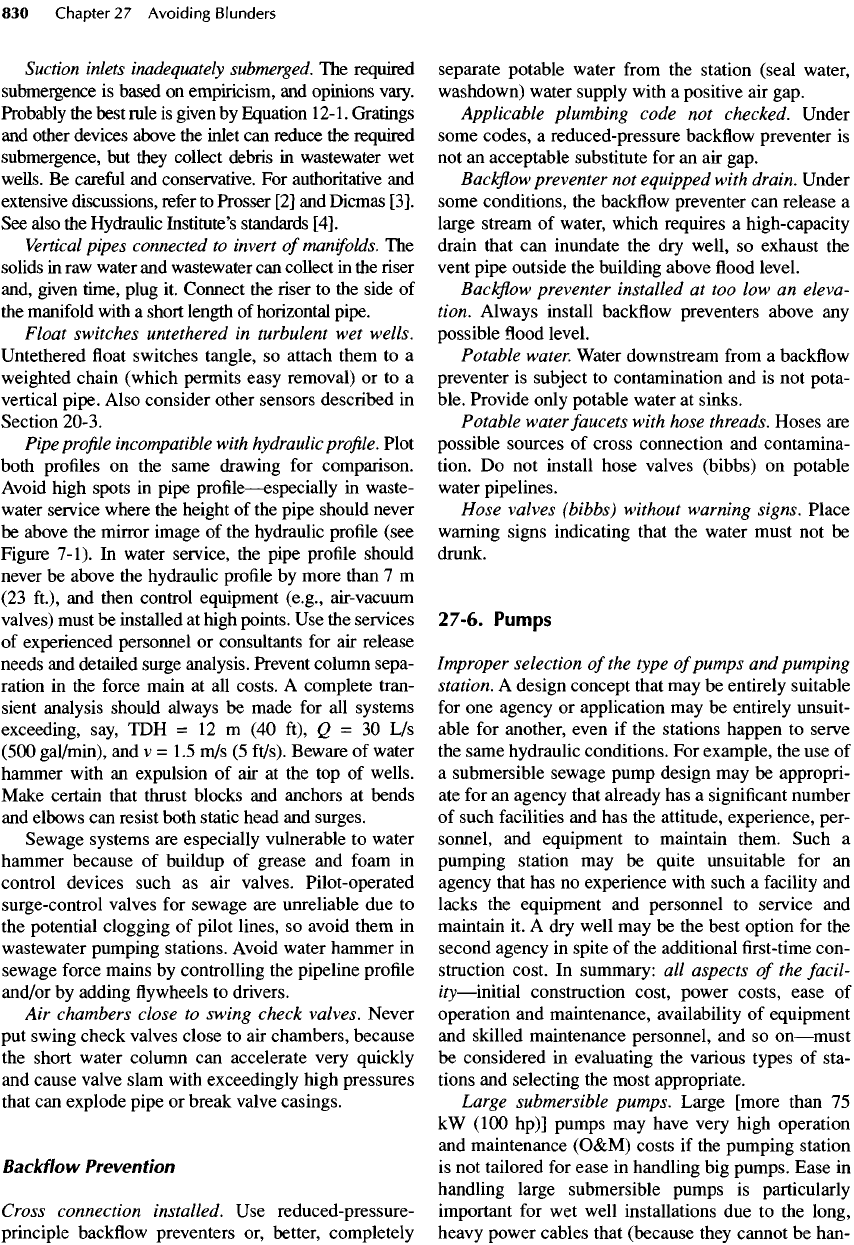
Suction
inlets
inadequately
submerged.
The
required
submergence
is
based
on
empiricism,
and
opinions
vary.
Probably
the
best rule
is
given
by
Equation
12-1.
Gratings
and
other devices above
the
inlet
can
reduce
the
required
submergence,
but
they collect debris
in
wastewater
wet
wells.
Be
careful
and
conservative.
For
authoritative
and
extensive discussions,
refer
to
Prosser
[2] and
Dicmas
[3].
See
also
the
Hydraulic Institute's standards
[4].
Vertical
pipes
connected
to
invert
of
manifolds.
The
solids
in raw
water
and
wastewater
can
collect
in the riser
and,
given time, plug
it.
Connect
the riser to the
side
of
the
manifold with
a
short length
of
horizontal pipe.
Float
switches
unt
ether
ed
in
turbulent
wet
wells.
Untethered
float
switches tangle,
so
attach them
to a
weighted chain (which permits easy removal)
or to a
vertical pipe. Also consider other sensors
described
in
Section 20-3.
Pipe
profile
incompatible
with
hydraulic
profile.
Plot
both
profiles
on the
same drawing
for
comparison.
Avoid
high spots
in
pipe
profile
—
especially
in
waste-
water
service where
the
height
of the
pipe should never
be
above
the
mirror image
of the
hydraulic
profile
(see
Figure 7-1).
In
water service,
the
pipe
profile
should
never
be
above
the
hydraulic profile
by
more than
7 m
(23
ft.),
and
then control equipment (e.g., air-vacuum
valves)
must
be
installed
at
high points.
Use the
services
of
experienced
personnel
or
consultants
for air
release
needs
and
detailed surge analysis. Prevent column sepa-
ration
in the
force main
at all
costs.
A
complete tran-
sient
analysis should always
be
made
for all
systems
exceeding, say,
TDH = 12 m (40
ft),
Q = 30 L/s
(500
gal/min),
and v = 1.5 m/s (5
ft/s).
Beware
of
water
hammer
with
an
expulsion
of air at the top of
wells.
Make
certain that thrust blocks
and
anchors
at
bends
and
elbows
can
resist both static head
and
surges.
Sewage systems
are
especially vulnerable
to
water
hammer because
of
buildup
of
grease
and
foam
in
control
devices
such
as air
valves.
Pilot-operated
surge-control
valves
for
sewage
are
unreliable
due to
the
potential clogging
of
pilot lines,
so
avoid them
in
wastewater
pumping stations. Avoid water hammer
in
sewage force mains
by
controlling
the
pipeline
profile
and/or
by
adding
flywheels to
drivers.
Air
chambers close
to
swing check valves. Never
put
swing check valves close
to air
chambers, because
the
short water column
can
accelerate very quickly
and
cause valve slam with exceedingly high pressures
that
can
explode pipe
or
break valve casings.
Backflow
Prevention
Cross
connection installed.
Use
reduced-pressure-
principle
backflow
preventers
or,
better, completely
separate potable water
from
the
station (seal water,
washdown) water supply with
a
positive
air
gap.
Applicable
plumbing
code
not
checked. Under
some
codes,
a
reduced-pressure
backflow
preventer
is
not an
acceptable substitute
for an air
gap.
Backflow
preventer
not
equipped
with drain. Under
some conditions,
the
backflow
preventer
can
release
a
large stream
of
water, which requires
a
high-capacity
drain that
can
inundate
the dry
well,
so
exhaust
the
vent pipe outside
the
building above
flood
level.
Backflow
preventer installed
at too low an
eleva-
tion. Always install
backflow
preventers above
any
possible
flood
level.
Potable water. Water downstream
from
a
backflow
preventer
is
subject
to
contamination
and is not
pota-
ble. Provide only potable water
at
sinks.
Potable water faucets with hose threads. Hoses
are
possible sources
of
cross connection
and
contamina-
tion.
Do not
install hose valves (bibbs)
on
potable
water
pipelines.
Hose
valves
(bibbs)
without warning signs.
Place
warning
signs indicating that
the
water must
not be
drunk.
27-6.
Pumps
Improper
selection
of the
type
of
pumps
and
pumping
station.
A
design concept that
may be
entirely suitable
for
one
agency
or
application
may be
entirely unsuit-
able
for
another, even
if the
stations happen
to
serve
the
same hydraulic conditions.
For
example,
the use of
a
submersible sewage pump design
may be
appropri-
ate for an
agency that already
has a
significant
number
of
such facilities
and has the
attitude, experience, per-
sonnel,
and
equipment
to
maintain them. Such
a
pumping station
may be
quite unsuitable
for an
agency that
has no
experience
with such
a
facility
and
lacks
the
equipment
and
personnel
to
service
and
maintain
it. A dry
well
may be the
best option
for the
second agency
in
spite
of the
additional
first-time
con-
struction
cost.
In
summary:
all
aspects
of the
facil-
ity
—
initial
construction cost, power costs, ease
of
operation
and
maintenance, availability
of
equipment
and
skilled maintenance personnel,
and so
on
—
must
be
considered
in
evaluating
the
various types
of
sta-
tions
and
selecting
the
most appropriate.
Large
submersible pumps. Large [more than
75
kW
(100 hp)] pumps
may
have very high operation
and
maintenance (O&M) costs
if the
pumping station
is
not
tailored
for
ease
in
handling
big
pumps. Ease
in
handling
large submersible pumps
is
particularly
important
for wet
well installations
due to the
long,
heavy
power cables that (because they cannot
be
han-
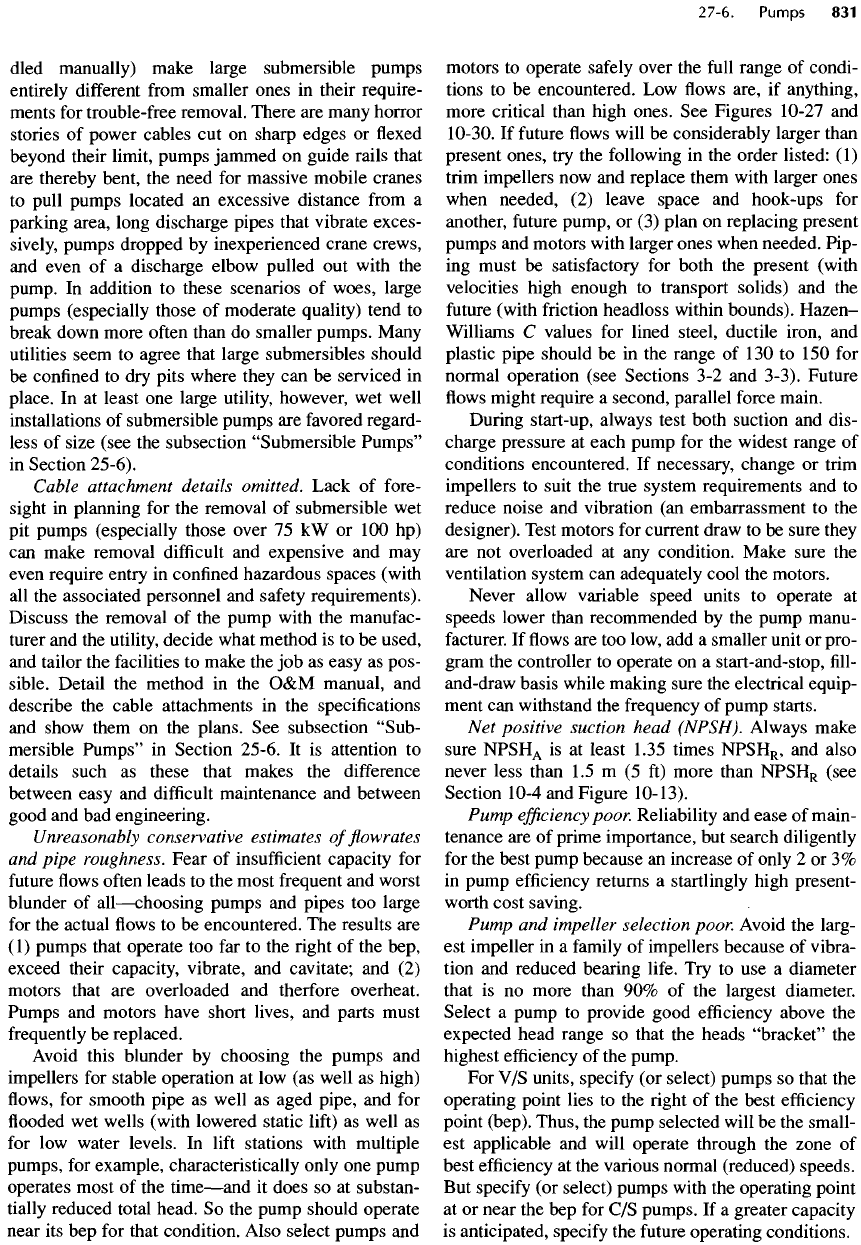
died
manually) make large submersible pumps
entirely
different
from
smaller ones
in
their require-
ments
for
trouble-free removal.
There
are
many horror
stories
of
power cables
cut on
sharp edges
or
flexed
beyond their limit, pumps jammed
on
guide rails that
are
thereby bent,
the
need
for
massive mobile cranes
to
pull pumps located
an
excessive distance
from
a
parking
area, long discharge pipes that vibrate exces-
sively,
pumps dropped
by
inexperienced crane crews,
and
even
of a
discharge elbow pulled
out
with
the
pump.
In
addition
to
these scenarios
of
woes, large
pumps
(especially those
of
moderate quality) tend
to
break down more
often
than
do
smaller pumps. Many
utilities seem
to
agree that large submersibles should
be
confined
to dry
pits where they
can be
serviced
in
place.
In at
least
one
large utility, however,
wet
well
installations
of
submersible pumps
are
favored
regard-
less
of
size (see
the
subsection
"Submersible
Pumps"
in
Section 25-6).
Cable
attachment details omitted. Lack
of
fore-
sight
in
planning
for the
removal
of
submersible
wet
pit
pumps (especially those over
75 kW or 100
hp)
can
make removal
difficult
and
expensive
and may
even
require entry
in
confined
hazardous spaces (with
all
the
associated personnel
and
safety
requirements).
Discuss
the
removal
of the
pump with
the
manufac-
turer
and the
utility, decide what method
is to be
used,
and
tailor
the
facilities
to
make
the job as
easy
as
pos-
sible. Detail
the
method
in the O&M
manual,
and
describe
the
cable attachments
in the
specifications
and
show them
on the
plans.
See
subsection "Sub-
mersible Pumps"
in
Section 25-6.
It is
attention
to
details
such
as
these that makes
the
difference
between easy
and
difficult
maintenance
and
between
good
and bad
engineering.
Unreasonably
conservative estimates
offlowrates
and
pipe roughness.
Fear
of
insufficient
capacity
for
future
flows
often
leads
to the
most
frequent
and
worst
blunder
of
all
—
choosing
pumps
and
pipes
too
large
for
the
actual
flows to be
encountered.
The
results
are
(1)
pumps that operate
too far to the
right
of the
bep,
exceed their capacity, vibrate,
and
cavitate;
and (2)
motors that
are
overloaded
and
therfore overheat.
Pumps
and
motors have short lives,
and
parts must
frequently
be
replaced.
Avoid
this blunder
by
choosing
the
pumps
and
impellers
for
stable operation
at low (as
well
as
high)
flows,
for
smooth pipe
as
well
as
aged pipe,
and for
flooded
wet
wells (with lowered static
lift)
as
well
as
for
low
water levels.
In
lift
stations with multiple
pumps,
for
example, characteristically only
one
pump
operates most
of the
time
—
and
it
does
so at
substan-
tially
reduced total head.
So the
pump should operate
near
its bep for
that condition. Also select pumps
and
motors
to
operate safely over
the
full
range
of
condi-
tions
to be
encountered.
Low flows
are,
if
anything,
more
critical
than high ones.
See
Figures 10-27
and
10-30.
If
future
flows
will
be
considerably larger than
present ones,
try the
following
in the
order listed:
(1)
trim
impellers
now and
replace them with larger ones
when needed,
(2)
leave space
and
hook-ups
for
another,
future
pump,
or (3)
plan
on
replacing present
pumps
and
motors with larger ones when needed. Pip-
ing
must
be
satisfactory
for
both
the
present (with
velocities high enough
to
transport solids)
and the
future
(with friction headloss within bounds).
Hazen-
Williams
C
values
for
lined steel, ductile iron,
and
plastic
pipe should
be in the
range
of 130 to 150 for
normal operation (see Sections
3-2 and
3-3). Future
flows
might
require
a
second, parallel force main.
During start-up, always test both suction
and
dis-
charge pressure
at
each pump
for the
widest range
of
conditions encountered.
If
necessary, change
or
trim
impellers
to
suit
the
true system requirements
and to
reduce noise
and
vibration
(an
embarrassment
to the
designer). Test motors
for
current draw
to be
sure they
are not
overloaded
at any
condition. Make sure
the
ventilation system
can
adequately cool
the
motors.
Never allow variable speed units
to
operate
at
speeds lower than recommended
by the
pump manu-
facturer.
If flows are too
low,
add a
smaller unit
or
pro-
gram
the
controller
to
operate
on a
start-and-stop,
fill-
and-draw
basis while making sure
the
electrical equip-
ment
can
withstand
the
frequency
of
pump starts.
Net
positive suction head
(NPSH).
Always make
sure
NPSH
A
is at
least 1.35 times
NPSH
R
,
and
also
never less than
1.5 m (5 ft)
more than
NPSH
R
(see
Section 10-4
and
Figure
10-13).
Pump
efficiency
poor. Reliability
and
ease
of
main-
tenance
are of
prime importance,
but
search diligently
for
the
best pump because
an
increase
of
only
2 or 3%
in
pump
efficiency
returns
a
startlingly
high present-
worth
cost saving.
Pump
and
impeller selection poor. Avoid
the
larg-
est
impeller
in a
family
of
impellers because
of
vibra-
tion
and
reduced bearing life.
Try to use a
diameter
that
is no
more than
90% of the
largest diameter.
Select
a
pump
to
provide good
efficiency
above
the
expected head range
so
that
the
heads
"bracket"
the
highest
efficiency
of the
pump.
For V/S
units, specify
(or
select) pumps
so
that
the
operating point
lies
to the right of the
best
efficiency
point (bep). Thus,
the
pump selected will
be the
small-
est
applicable
and
will operate through
the
zone
of
best
efficiency
at the
various normal (reduced) speeds.
But
specify
(or
select) pumps with
the
operating point
at
or
near
the bep for C/S
pumps.
If a
greater capacity
is
anticipated,
specify
the
future
operating conditions.
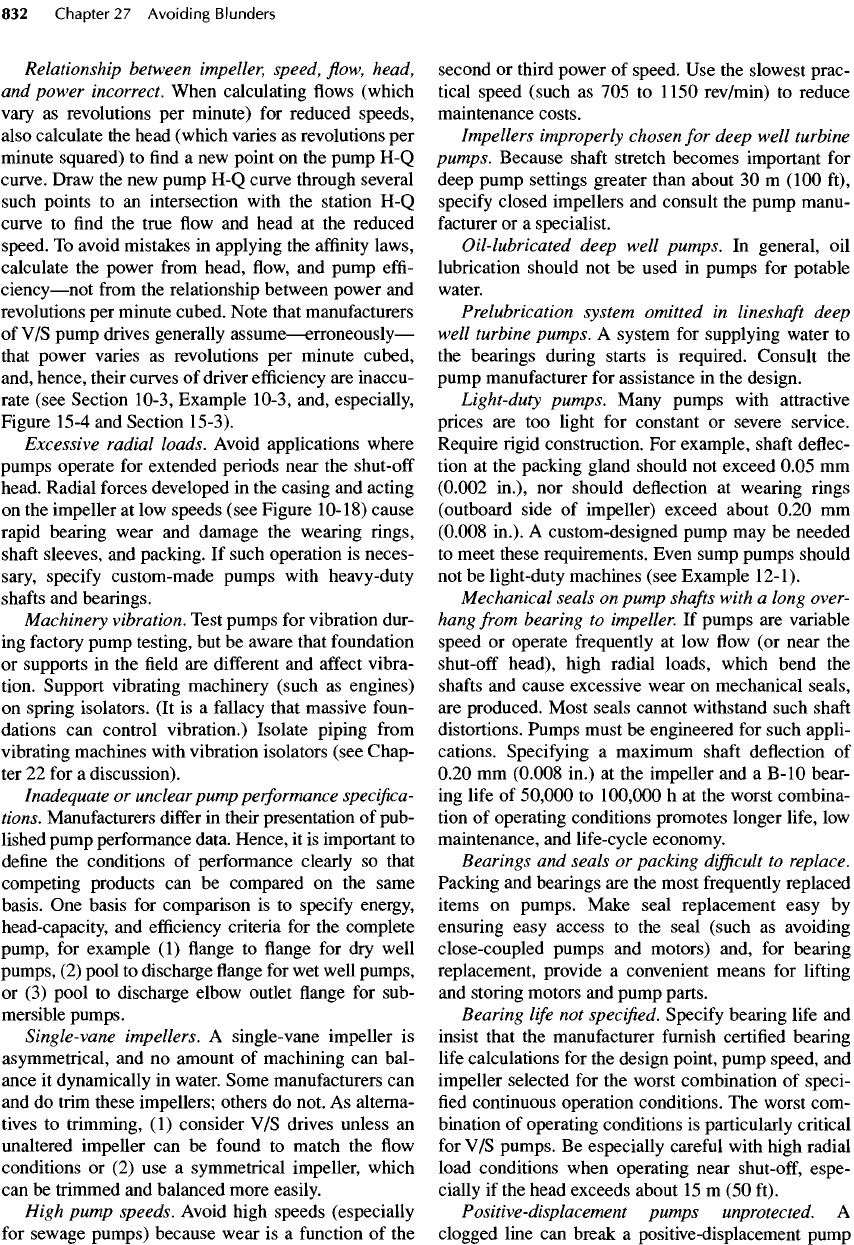
Relationship
between
impeller,
speed,
flow,
head,
and
power
incorrect.
When calculating
flows
(which
vary
as
revolutions
per
minute)
for
reduced speeds,
also calculate
the
head (which varies
as
revolutions
per
minute squared)
to find a new
point
on the
pump
H-Q
curve. Draw
the new
pump
H-Q
curve through several
such
points
to an
intersection with
the
station
H-Q
curve
to find the
true
flow and
head
at the
reduced
speed.
To
avoid mistakes
in
applying
the
affinity
laws,
calculate
the
power
from
head,
flow, and
pump
effi-
ciency
—
not
from
the
relationship between power
and
revolutions
per
minute cubed. Note that manufacturers
of
V/S
pump drives generally
assume
—
erroneously
—
that
power varies
as
revolutions
per
minute cubed,
and,
hence, their curves
of
driver
efficiency
are
inaccu-
rate (see Section 10-3, Example 10-3, and, especially,
Figure 15-4
and
Section 15-3).
Excessive
radial loads. Avoid applications where
pumps operate
for
extended periods near
the
shut-off
head. Radial forces developed
in the
casing
and
acting
on
the
impeller
at low
speeds (see Figure
10-18)
cause
rapid bearing wear
and
damage
the
wearing rings,
shaft
sleeves,
and
packing.
If
such operation
is
neces-
sary,
specify
custom-made pumps with heavy-duty
shafts
and
bearings.
Machinery
vibration. Test pumps
for
vibration dur-
ing
factory
pump testing,
but be
aware that foundation
or
supports
in the field are
different
and
affect
vibra-
tion. Support vibrating machinery (such
as
engines)
on
spring isolators.
(It is a
fallacy
that massive
foun-
dations
can
control vibration.) Isolate piping
from
vibrating
machines with vibration isolators (see Chap-
ter 22 for a
discussion).
Inadequate
or
unclear pump
performance
specifica-
tions.
Manufacturers
differ
in
their presentation
of
pub-
lished pump performance data. Hence,
it is
important
to
define
the
conditions
of
performance clearly
so
that
competing products
can be
compared
on the
same
basis.
One
basis
for
comparison
is to
specify
energy,
head-capacity,
and
efficiency
criteria
for the
complete
pump,
for
example
(1) flange to flange for dry
well
pumps,
(2)
pool
to
discharge
flange for wet
well pumps,
or
(3)
pool
to
discharge elbow outlet
flange for
sub-
mersible pumps.
Single-vane impellers.
A
single-
vane
impeller
is
asymmetrical,
and no
amount
of
machining
can
bal-
ance
it
dynamically
in
water. Some manufacturers
can
and
do
trim these impellers; others
do
not.
As
alterna-
tives
to
trimming,
(1)
consider
V/S
drives unless
an
unaltered impeller
can be
found
to
match
the flow
conditions
or (2) use a
symmetrical impeller, which
can
be
trimmed
and
balanced more easily.
High
pump speeds. Avoid high speeds (especially
for
sewage pumps) because wear
is a
function
of the
second
or
third power
of
speed.
Use the
slowest prac-
tical speed (such
as 705 to
1150
rev/min)
to
reduce
maintenance costs.
Impellers
improperly
chosen
for
deep
well turbine
pumps. Because
shaft
stretch becomes important
for
deep pump settings greater than about
30 m
(100 ft),
specify
closed impellers
and
consult
the
pump manu-
facturer
or a
specialist.
Oil-lubricated
deep
well pumps.
In
general,
oil
lubrication should
not be
used
in
pumps
for
potable
water.
Prelubrication
system omitted
in
lineshaft
deep
well
turbine pumps.
A
system
for
supplying water
to
the
bearings during starts
is
required. Consult
the
pump
manufacturer
for
assistance
in the
design.
Light-duty
pumps. Many pumps with attractive
prices
are too
light
for
constant
or
severe
service.
Require rigid construction.
For
example,
shaft
deflec-
tion
at the
packing gland should
not
exceed 0.05
mm
(0.002
in.),
nor
should deflection
at
wearing rings
(outboard side
of
impeller) exceed about 0.20
mm
(0.008
in.).
A
custom-designed pump
may be
needed
to
meet these requirements. Even sump pumps should
not
be
light-duty machines (see Example
12-1).
Mechanical
seals
on
pump
shafts
with
a
long
over-
hang
from bearing
to
impeller.
If
pumps
are
variable
speed
or
operate frequently
at low flow (or
near
the
shut-off
head), high radial loads, which bend
the
shafts
and
cause excessive wear
on
mechanical seals,
are
produced. Most seals cannot withstand such
shaft
distortions. Pumps must
be
engineered
for
such appli-
cations. Specifying
a
maximum
shaft
deflection
of
0.20
mm
(0.008
in.)
at the
impeller
and a
B-IO
bear-
ing
life
of
50,000
to
100,000
h at the
worst combina-
tion
of
operating conditions promotes longer
life,
low
maintenance,
and
life-cycle economy.
Bearings
and
seals
or
packing
difficult
to
replace.
Packing
and
bearings
are the
most frequently replaced
items
on
pumps. Make seal replacement easy
by
ensuring easy access
to the
seal (such
as
avoiding
close-coupled pumps
and
motors) and,
for
bearing
replacement, provide
a
convenient means
for
lifting
and
storing motors
and
pump parts.
Bearing
life
not
specified.
Specify bearing
life
and
insist that
the
manufacturer
furnish
certified
bearing
life
calculations
for the
design point, pump speed,
and
impeller selected
for the
worst combination
of
speci-
fied
continuous
operation conditions.
The
worst com-
bination
of
operating conditions
is
particularly critical
for
V/S
pumps.
Be
especially
careful
with high radial
load conditions when operating near
shut-off,
espe-
cially
if the
head exceeds about
15m
(50
ft).
Positive-displacement
pumps
unprotected.
A
clogged line
can
break
a
positive-displacement pump
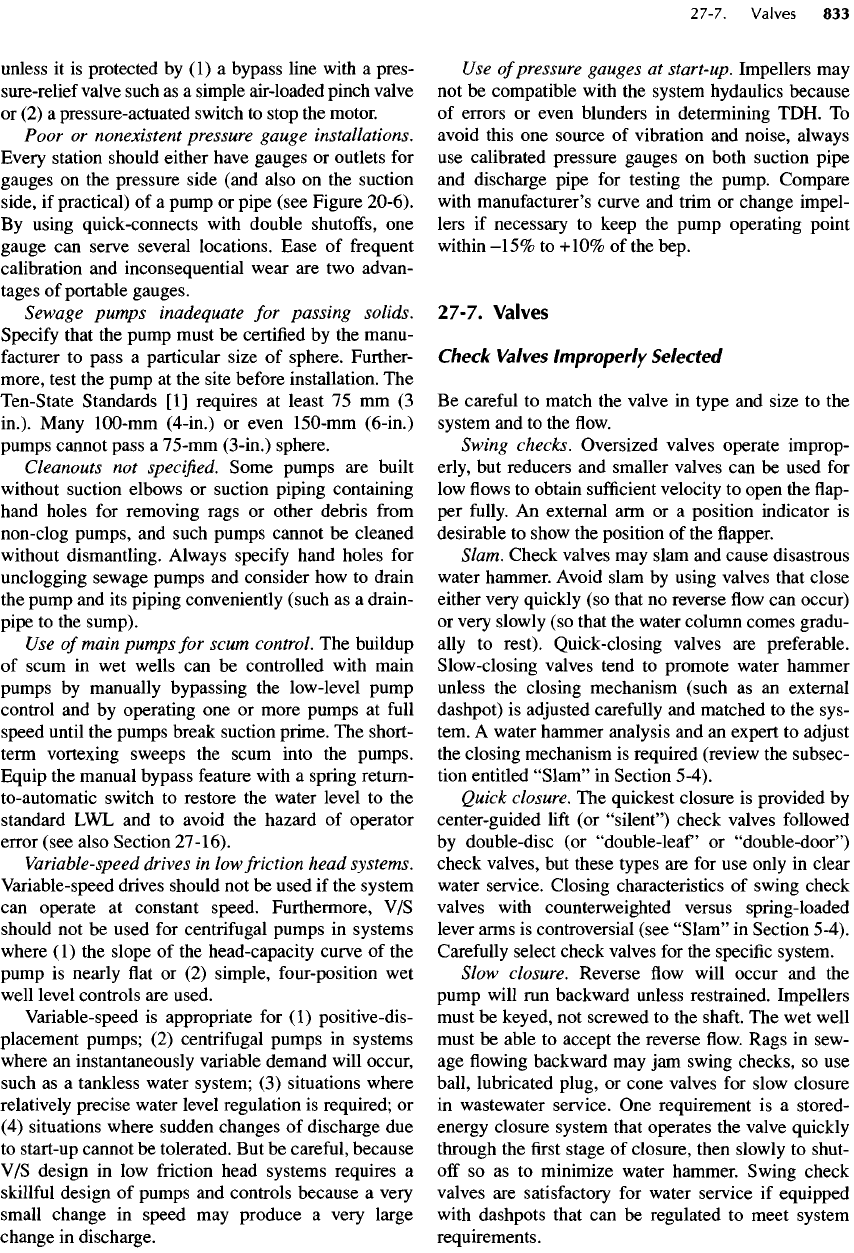
unless
it is
protected
by (1) a
bypass line with
a
pres-
sure-relief valve such
as a
simple air-loaded pinch valve
or
(2) a
pressure-actuated switch
to
stop
the
motor.
Poor
or
nonexistent pressure gauge installations.
Every
station should either have gauges
or
outlets
for
gauges
on the
pressure side (and also
on the
suction
side,
if
practical)
of a
pump
or
pipe (see Figure
20-6).
By
using quick-connects with double
shutoffs,
one
gauge
can
serve several locations. Ease
of
frequent
calibration
and
inconsequential wear
are two
advan-
tages
of
portable gauges.
Sewage
pumps inadequate
for
passing solids.
Specify
that
the
pump must
be
certified
by the
manu-
facturer
to
pass
a
particular size
of
sphere. Further-
more, test
the
pump
at the
site before installation.
The
Ten-State Standards
[1]
requires
at
least
75 mm (3
in.).
Many
100-mm
(4-in.)
or
even
150-mm
(6-in.)
pumps
cannot pass
a
75-mm
(3-in.) sphere.
Cleanouts
not
specified.
Some pumps
are
built
without
suction elbows
or
suction piping containing
hand
holes
for
removing rags
or
other debris
from
non-clog pumps,
and
such pumps cannot
be
cleaned
without
dismantling. Always
specify
hand holes
for
unclogging sewage pumps
and
consider
how to
drain
the
pump
and its
piping conveniently (such
as a
drain-
pipe
to the
sump).
Use
of
main pumps
for
scum control.
The
buildup
of
scum
in wet
wells
can be
controlled with main
pumps
by
manually bypassing
the
low-level pump
control
and by
operating
one or
more pumps
at
full
speed until
the
pumps break suction prime.
The
short-
term
vortexing
sweeps
the
scum into
the
pumps.
Equip
the
manual bypass feature with
a
spring
return-
to-automatic
switch
to
restore
the
water level
to the
standard
LWL and to
avoid
the
hazard
of
operator
error (see also
Section
27-16).
Variable
-speed
drives
in low
friction
head
systems.
Variable-speed drives should
not be
used
if the
system
can
operate
at
constant speed. Furthermore,
V/S
should
not be
used
for
centrifugal pumps
in
systems
where
(1) the
slope
of the
head-capacity curve
of the
pump
is
nearly
flat or (2)
simple, four-position
wet
well level controls
are
used.
Variable-speed
is
appropriate
for (1)
positive-dis-
placement pumps;
(2)
centrifugal
pumps
in
systems
where
an
instantaneously variable demand will occur,
such
as a
tankless water system;
(3)
situations where
relatively
precise
water level regulation
is
required;
or
(4)
situations where sudden changes
of
discharge
due
to
start-up cannot
be
tolerated.
But be
careful,
because
V/S
design
in low
friction
head systems requires
a
skillful
design
of
pumps
and
controls because
a
very
small change
in
speed
may
produce
a
very large
change
in
discharge.
Use
of
pressure gauges
at
start-up.
Impellers
may
not
be
compatible with
the
system hydaulics because
of
errors
or
even blunders
in
determining TDH.
To
avoid
this
one
source
of
vibration
and
noise, always
use
calibrated pressure gauges
on
both suction
pipe
and
discharge pipe
for
testing
the
pump. Compare
with
manufacturer's curve
and
trim
or
change impel-
lers
if
necessary
to
keep
the
pump operating point
within
-15%
to
+10%
of the
bep.
27-7.
Valves
Check
Valves
Improperly
Selected
Be
careful
to
match
the
valve
in
type
and
size
to the
system
and to the flow.
Swing
checks. Oversized valves operate improp-
erly,
but
reducers
and
smaller valves
can be
used
for
low
flows to
obtain
sufficient
velocity
to
open
the flap-
per
fully.
An
external
arm or a
position indicator
is
desirable
to
show
the
position
of the flapper.
Slam. Check valves
may
slam
and
cause disastrous
water hammer. Avoid slam
by
using valves that close
either very quickly
(so
that
no
reverse
flow can
occur)
or
very slowly
(so
that
the
water column comes gradu-
ally
to
rest). Quick-closing valves
are
preferable.
Slow-closing valves tend
to
promote water hammer
unless
the
closing mechanism (such
as an
external
dashpot)
is
adjusted
carefully
and
matched
to the
sys-
tem.
A
water hammer analysis
and an
expert
to
adjust
the
closing mechanism
is
required (review
the
subsec-
tion
entitled
"Slam"
in
Section 5-4).
Quick
closure.
The
quickest closure
is
provided
by
center-guided
lift
(or
"silent")
check valves followed
by
double-disc
(or
"double-leaf
or
"double-door")
check valves,
but
these types
are for use
only
in
clear
water service. Closing characteristics
of
swing check
valves
with counterweighted versus spring-loaded
lever arms
is
controversial (see
"Slam"
in
Section 5-4).
Carefully
select
check valves
for the
specific
system.
Slow
closure. Reverse
flow
will occur
and the
pump
will
run
backward unless restrained. Impellers
must
be
keyed,
not
screwed
to the
shaft.
The wet
well
must
be
able
to
accept
the
reverse
flow.
Rags
in
sew-
age flowing
backward
may jam
swing checks,
so use
ball, lubricated plug,
or
cone
valves
for
slow closure
in
wastewater service.
One
requirement
is a
stored-
energy closure system that operates
the
valve quickly
through
the first
stage
of
closure, then slowly
to
shut-
off
so as to
minimize water hammer. Swing check
valves
are
satisfactory
for
water service
if
equipped
with
dashpots that
can be
regulated
to
meet system
requirements.
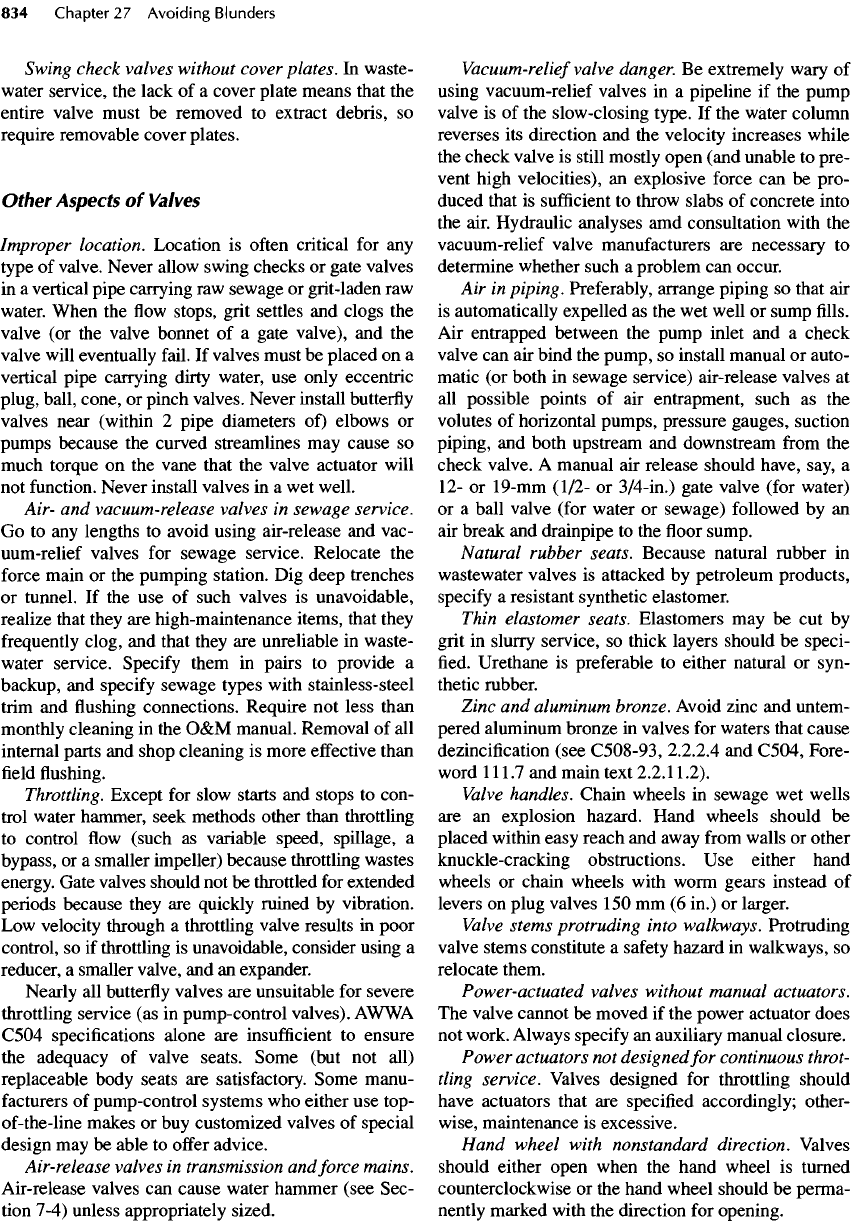
Swing
check valves without cover
plates.
In
waste-
water
service,
the
lack
of a
cover plate means that
the
entire valve must
be
removed
to
extract debris,
so
require removable cover plates.
Other Aspects
of
Valves
Improper
location. Location
is
often
critical
for any
type
of
valve. Never allow swing checks
or
gate valves
in
a
vertical pipe carrying
raw
sewage
or
grit-laden
raw
water.
When
the flow
stops, grit settles
and
clogs
the
valve
(or the
valve bonnet
of a
gate valve),
and the
valve
will eventually
fail.
If
valves must
be
placed
on a
vertical pipe carrying dirty water,
use
only eccentric
plug,
ball, cone,
or
pinch valves. Never install
butterfly
valves
near (within
2
pipe diameters
of)
elbows
or
pumps
because
the
curved streamlines
may
cause
so
much
torque
on the
vane that
the
valve actuator will
not
function.
Never install valves
in a wet
well.
Air-
and
vacuum-release valves
in
sewage service.
Go
to any
lengths
to
avoid using
air-release
and
vac-
uum-relief valves
for
sewage
service.
Relocate
the
force
main
or the
pumping station.
Dig
deep trenches
or
tunnel.
If the use of
such valves
is
unavoidable,
realize that they
are
high-maintenance items, that they
frequently
clog,
and
that they
are
unreliable
in
waste-
water service.
Specify
them
in
pairs
to
provide
a
backup,
and
specify
sewage types with stainless-steel
trim
and flushing
connections. Require
not
less than
monthly
cleaning
in the O&M
manual. Removal
of all
internal parts
and
shop cleaning
is
more
effective
than
field
flushing.
Throttling.
Except
for
slow starts
and
stops
to
con-
trol water hammer,
seek
methods other than throttling
to
control
flow
(such
as
variable speed,
spillage,
a
bypass,
or a
smaller impeller) because throttling wastes
energy.
Gate valves should
not be
throttled
for
extended
periods because they
are
quickly ruined
by
vibration.
Low
velocity through
a
throttling valve results
in
poor
control,
so if
throttling
is
unavoidable, consider using
a
reducer,
a
smaller valve,
and an
expander.
Nearly
all
butterfly
valves
are
unsuitable
for
severe
throttling service
(as in
pump-control valves).
AWWA
C504
specifications alone
are
insufficient
to
ensure
the
adequacy
of
valve seats. Some (but
not
all)
replaceable
body seats
are
satisfactory. Some manu-
facturers
of
pump-control systems
who
either
use
top-
of-the-line
makes
or buy
customized valves
of
special
design
may be
able
to
offer
advice.
Air-release
valves
in
transmission
and
force
mains.
Air-release valves
can
cause water hammer (see Sec-
tion 7-4) unless appropriately sized.
Vacuum-relief
valve
danger.
Be
extremely wary
of
using
vacuum-relief valves
in a
pipeline
if the
pump
valve
is of the
slow-closing type.
If the
water column
reverses
its
direction
and the
velocity increases while
the
check valve
is
still mostly open (and unable
to
pre-
vent high
velocities),
an
explosive force
can be
pro-
duced that
is
sufficient
to
throw slabs
of
concrete
into
the
air. Hydraulic analyses
amd
consultation with
the
vacuum-relief valve manufacturers
are
necessary
to
determine whether such
a
problem
can
occur.
Air in
piping. Preferably, arrange piping
so
that
air
is
automatically expelled
as the wet
well
or
sump
fills.
Air
entrapped between
the
pump inlet
and a
check
valve
can air
bind
the
pump,
so
install manual
or
auto-
matic
(or
both
in
sewage service)
air-release
valves
at
all
possible
points
of air
entrapment, such
as the
volutes
of
horizontal pumps, pressure gauges, suction
piping,
and
both upstream
and
downstream
from
the
check valve.
A
manual
air
release
should have, say,
a
12-
or
19-mm
(1/2-
or
3/4-in.) gate valve (for water)
or a
ball valve (for water
or
sewage) followed
by an
air
break
and
drainpipe
to the floor
sump.
Natural
rubber seats. Because natural rubber
in
wastewater valves
is
attacked
by
petroleum products,
specify
a
resistant synthetic elastomer.
Thin
elastomer seats. Elastomers
may be cut by
grit
in
slurry service,
so
thick layers should
be
speci-
fied.
Urethane
is
preferable
to
either natural
or
syn-
thetic rubber.
Zinc
and
aluminum bronze. Avoid zinc
and
untem-
pered
aluminum bronze
in
valves
for
waters that cause
dezincification
(see
C508-93,
2.2.2.4
and
C504,
Fore-
word
1 1 1
.7
and
main text
2.2.
1 1
.2).
Valve
handles. Chain wheels
in
sewage
wet
wells
are an
explosion hazard. Hand wheels should
be
placed within easy reach
and
away
from
walls
or
other
knuckle-cracking obstructions.
Use
either hand
wheels
or
chain wheels with worm
gears
instead
of
levers
on
plug valves
150
mm (6
in.)
or
larger.
Valve
stems protruding into walkways. Protruding
valve
stems constitute
a
safety
hazard
in
walkways,
so
relocate
them.
Power-actuated
valves without manual actuators.
The
valve cannot
be
moved
if the
power actuator does
not
work. Always
specify
an
auxiliary manual closure.
Power actuators
not
designed
for
continuous
throt-
tling
service. Valves designed
for
throttling should
have
actuators that
are
specified accordingly; other-
wise, maintenance
is
excessive.
Hand
wheel with nonstandard direction. Valves
should either open when
the
hand wheel
is
turned
counterclockwise
or the
hand wheel should
be
perma-
nently marked with
the
direction
for
opening.
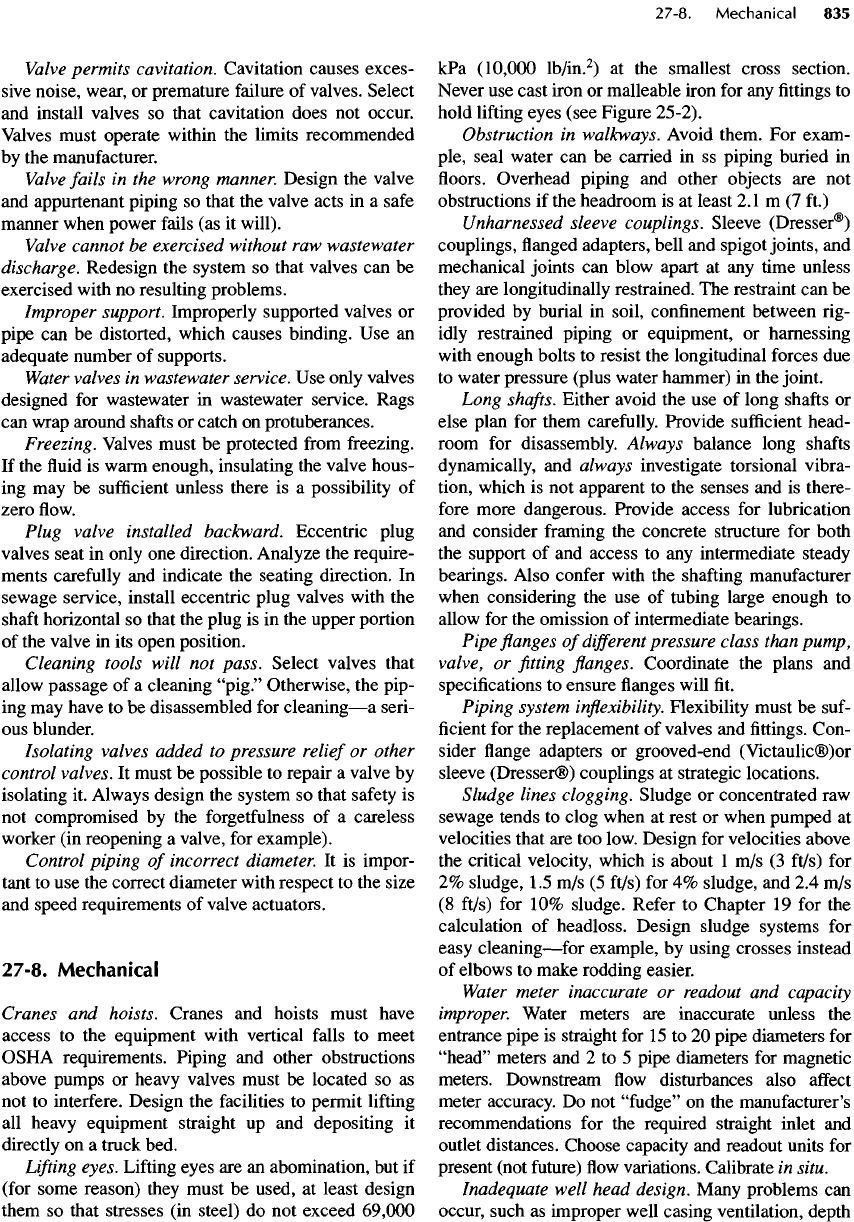
Valve
permits cavitation. Cavitation causes exces-
sive
noise, wear,
or
premature failure
of
valves.
Select
and
install valves
so
that cavitation does
not
occur.
Valves
must operate within
the
limits recommended
by
the
manufacturer.
Valve
fails
in the
wrong manner. Design
the
valve
and
appurtenant piping
so
that
the
valve acts
in a
safe
manner when power fails
(as it
will).
Valve
cannot
be
exercised without
raw
wastewater
discharge.
Redesign
the
system
so
that valves
can be
exercised with
no
resulting problems.
Improper
support. Improperly supported valves
or
pipe
can be
distorted, which causes binding.
Use an
adequate number
of
supports.
Water
valves
in
wastewater
service.
Use
only valves
designed
for
wastewater
in
wastewater service. Rags
can
wrap around
shafts
or
catch
on
protuberances.
Freezing.
Valves must
be
protected
from
freezing.
If
the fluid is
warm enough, insulating
the
valve hous-
ing may be
sufficient
unless there
is a
possibility
of
zero
flow.
Plug
valve installed backward.
Eccentric
plug
valves
seat
in
only
one
direction. Analyze
the
require-
ments
carefully
and
indicate
the
seating direction.
In
sewage
service, install eccentric plug valves with
the
shaft
horizontal
so
that
the
plug
is in the
upper portion
of
the
valve
in its
open position.
Cleaning
tools will
not
pass.
Select valves that
allow
passage
of a
cleaning
"pig."
Otherwise,
the
pip-
ing may
have
to be
disassembled
for
cleaning
—
a
seri-
ous
blunder.
Isolating
valves
added
to
pressure
relief
or
other
control
valves.
It
must
be
possible
to
repair
a
valve
by
isolating
it.
Always design
the
system
so
that safety
is
not
compromised
by the
forgetfulness
of a
careless
worker
(in
reopening
a
valve,
for
example).
Control
piping
of
incorrect diameter.
It is
impor-
tant
to use the
correct diameter with respect
to the
size
and
speed requirements
of
valve actuators.
27-8.
Mechanical
Cranes
and
hoists. Cranes
and
hoists must have
access
to the
equipment with vertical
falls
to
meet
OSHA requirements. Piping
and
other obstructions
above pumps
or
heavy valves must
be
located
so as
not to
interfere. Design
the
facilities
to
permit
lifting
all
heavy equipment straight
up and
depositing
it
directly
on a
truck bed.
Lifting
eyes.
Lifting
eyes
are an
abomination,
but if
(for
some reason) they must
be
used,
at
least
design
them
so
that
stresses
(in
steel)
do not
exceed
69,000
kPa
(10,000
lb/in.
2
)
at the
smallest cross section.
Never
use
cast iron
or
malleable iron
for any fittings to
hold
lifting
eyes (see Figure 25-2).
Obstruction
in
walkways. Avoid them.
For
exam-
ple, seal water
can be
carried
in ss
piping buried
in
floors.
Overhead piping
and
other objects
are not
obstructions
if the
headroom
is at
least
2.1
m (7
ft.)
Unharnessed
sleeve couplings. Sleeve
(Dresser®)
couplings,
flanged
adapters, bell
and
spigot joints,
and
mechanical joints
can
blow apart
at any
time unless
they
are
longitudinally restrained.
The
restraint
can be
provided
by
burial
in
soil, confinement between
rig-
idly restrained piping
or
equipment,
or
harnessing
with
enough bolts
to
resist
the
longitudinal forces
due
to
water pressure (plus water hammer)
in the
joint.
Long
shafts.
Either avoid
the use of
long
shafts
or
else
plan
for
them carefully. Provide
sufficient
head-
room
for
disassembly. Always balance long
shafts
dynamically,
and
always investigate torsional vibra-
tion, which
is not
apparent
to the
senses
and is
there-
fore
more dangerous. Provide access
for
lubrication
and
consider framing
the
concrete structure
for
both
the
support
of and
access
to any
intermediate steady
bearings. Also confer with
the
shafting manufacturer
when
considering
the use of
tubing large enough
to
allow
for the
omission
of
intermediate bearings.
Pipe
flanges
of
different
pressure class than pump,
valve,
or fitting flanges.
Coordinate
the
plans
and
specifications
to
ensure
flanges
will
fit.
Piping
system
inflexibility.
Flexibility
must
be
suf-
ficient
for
the
replacement
of
valves
and fittings.
Con-
sider
flange
adapters
or
grooved-end
(Victaulic(D)or
sleeve
(Dresser®)
couplings
at
strategic locations.
Sludge
lines clogging. Sludge
or
concentrated
raw
sewage tends
to
clog when
at
rest
or
when pumped
at
velocities that
are too
low. Design
for
velocities above
the
critical velocity, which
is
about
1 m/s (3
ft/s)
for
2%
sludge,
1.5 m/s (5
ft/s)
for 4%
sludge,
and 2.4 m/s
(8
ft/s)
for 10%
sludge. Refer
to
Chapter
19 for the
calculation
of
headloss. Design sludge systems
for
easy
cleaning
—
for
example,
by
using crosses instead
of
elbows
to
make rodding
easier.
Water
meter inaccurate
or
readout
and
capacity
improper.
Water meters
are
inaccurate unless
the
entrance pipe
is
straight
for 15 to 20
pipe diameters
for
"head"
meters
and 2 to 5
pipe
diameters
for
magnetic
meters. Downstream
flow
disturbances also
affect
meter accuracy.
Do not
"fudge"
on the
manufacturer's
recommendations
for the
required straight inlet
and
outlet distances. Choose capacity
and
readout units
for
present (not
future)
flow
variations. Calibrate
in
situ.
Inadequate
well
head design. Many problems
can
occur, such
as
improper well casing ventilation, depth

gauge,
tap for raw
water samples, clearance
of top
casing above
the
floor,
and
pressure gauge
for
pump
testing. Review sanitary codes
and
engage
a
well
pump
specialist.
Flywheels
used
for
water hammer control. Fly-
wheels impose very severe service
for
bearings.
Use
oversize bearings
(100,000
hour,
L-IO
life)
and flexi-
ble
couplings
to the flywheel
shaft.
27-9.
Electrical
Control
system
too
complex
for
contractor
or
opera-
tors.
Assess
and do not
exceed
the
level
of
sophistica-
tion
of
local contractors
and the
client's personnel.
Keep
it
simple.
Corrosion
in
control panels. Locate control panels
in
a
clean,
dry
environment.
If
they must
be in a
damp
environment,
use
NEMA
4 or 12
panels
and
purge
them
with
dry
air. NEMA
4
panels require
thermo-
static
heaters
in
most
of the
United States because
of
nighttime
moisture condensation
in the
cabinet.
Use
moisture-absorbing cartridges
for
corrosion control
in
all
panels.
Excessive
starts
per
hour.
Starting motors
and
motor starters
too
frequently reduces their
life.
Con-
tact
the
manufacturers
—
not
the
sales
representative
—
of
both
the
motor
and the
starter regarding
the
number
of
allowable starts
per
hour
and
obtain guarantees
in
writing.
Consider
(1)
"soft-starting"
with reduced-
voltage,
solid-state starters
for
unlimited starts
per
hour
or (2) V/S
pumping.
Big
motors.
Big
motors
may not
start
on the first
try.
Then
the
operators must wait
for
hours
for a
sec-
ond
try.
To
avoid
the
delay,
specify
enough thermal
capacity
for at
least
two
starts.
An
operator,
who
should
be
standing
by,
should stop
the
motor
if it
fails
to
reach
full
speed
in 10
seconds. Correct
the
cause
of
the
malfunction before attempting
a
restart.
Junction
boxes
in wet
wells. Avoid placing junction
boxes
in wet
wells
or at any
location where water could
enter
the
box. Boxes
in
moisture-laden atmospheres
accumulate
water that
can
travel along conductors
and
cause
serious
faults.
In a wet
well,
a
worker must enter
a
hazardous,
confined
space
to
disconnect,
for
example,
a
submersible pump.
One
means
to
keep junction boxes
out
of wet
wells
is
shown
in
Figure
17-21.
If
there
is no
alternative,
specify
watertight motor
and
device termi-
nations.
Keep moisture
from
entering
by filling the
junction
box
with potting compound and,
for
submers-
ible motors, also
specify
non-wicking cable.
Inadequate
lighting
of
work areas. Review lighting
needs with
the
operating personnel
and the
electrical
engineer. Operating panels should
be
lighted with
a
minimum
of 500 lux (50 ft
-
cd),
but 200 lux (20 ft
-
cd) is
adequate
for the
pump room.
Portable
work
lights
are
cheaper than
fixed
lights
and are
actually
better. Check
the
hazard rating. Install guards
on
lamps
and
ensure easy access
for
replacement.
Add a
few
incandescent lamps
to
provide instantaneous light
to
augment lighting that requires
a
long warm-up time
before
reaching
full
brilliance.
Inadequate
or
dangerous outlet receptacles.
Always
specify
GFCI
receptacles
and
always test
them. Plan enough
receptacles
for
power tools, elec-
tric hoists,
and
lights.
Phase
not
protected.
Use
breakers,
not
fuses,
on
motor-control
and
other three-phase circuits. Specify
a
three-phase monitoring instrument
on the
incoming
power line
to
protect against
undervoltage
or a
loss
of
phase.
Improperly
sized circuit breakers. Specify properly
sized circuit breakers
to
protect against
(1)
short cir-
cuits,
(2)
overloading over
a
short time interval,
and
(3)
nuisance tripping.
All
electrical
equipment must
have
adequate withstand ratings.
Improper
grounding.
All
electrical (and mechani-
cal) equipment must
be
properly grounded (see
"Grounding"
in
Section 8-5).
Power failures. Power failures will occur,
so
design
the
system
to
prevent column separation
and
other
disasters.
Add
backup
in the
form
of
stored
energy
to
operate
slow-closing
valves.
Power
supply
inadequate. Check with
the
power
company
before beginning
the
design.
Positive-displacement
pumps with high static
heads
or
long
force mains. These sometimes require high-
slip
(8 to
13%)
"D"
motors
to
accelerate properly
the
tons
of
liquid
in a
force main. Check
the
pump
and
operating characteristics with
the
motor manufacturer.
Transfer
switches without time
delay
in
neutral.
The field
voltages
on
motors driving loads with
a
large
WR
2
do not
collapse
rapidly.
If the
motor
is
trans-
ferred
quickly
from
one
power source
to
another (say,
to
an
emergency generator
or
vice versa)
and if the
two
sources
are out of
sync, mechanical forces that
are
large enough
to
twist
shafts,
break couplings,
and
tear
windings
out of
motors
are
produced.
Specify
a
trans-
fer
switch with
an
adjustable time delay
in
neutral.
Usually
20 to 30
cycles
is a
sufficient
delay.
Wet
well electrical equipment
not
explosionproof.
Always
classify
sewage
wet
wells
as
Class
I,
Group
D,
Division
1 or 2 in
accordance with
the
NEC. Elec-
trical
equipment should
be
explosionproof.
Use
non-
sparking
tools
and
safe
maintenance
practices
when
working
in or
around
wet
wells.
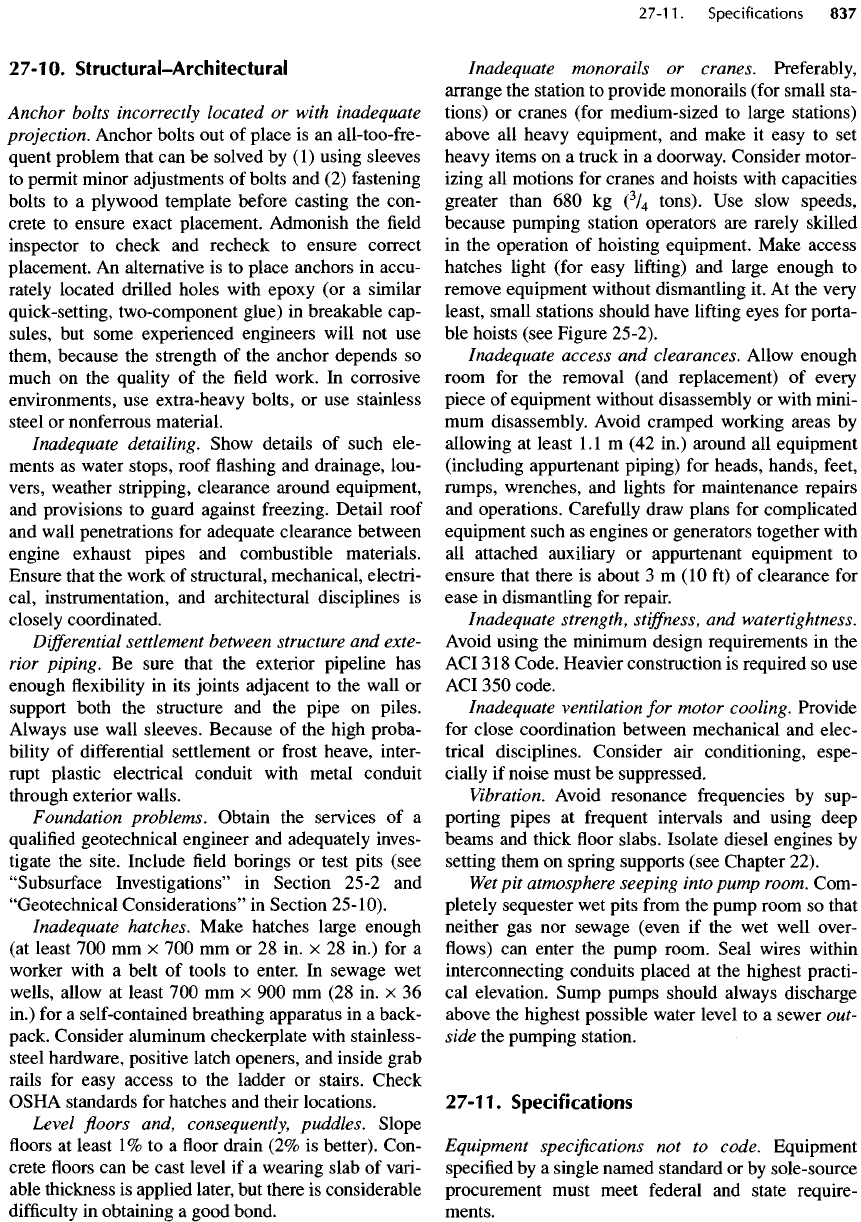
27-10.
Structural-Architectural
Anchor bolts
incorrectly
located
or
with inadequate
projection.
Anchor bolts
out of
place
is an
all-too-fre-
quent
problem that
can be
solved
by (1)
using sleeves
to
permit minor adjustments
of
bolts
and (2)
fastening
bolts
to a
plywood template before casting
the
con-
crete
to
ensure exact placement. Admonish
the field
inspector
to
check
and
recheck
to
ensure correct
placement.
An
alternative
is to
place anchors
in
accu-
rately located
drilled
holes
with epoxy
(or a
similar
quick-setting,
two-component glue)
in
breakable cap-
sules,
but
some experienced engineers will
not use
them,
because
the
strength
of the
anchor depends
so
much
on the
quality
of the field
work.
In
corrosive
environments,
use
extra-heavy
bolts,
or use
stainless
steel
or
nonferrous
material.
Inadequate
detailing. Show details
of
such ele-
ments
as
water stops, roof
flashing and
drainage, lou-
vers,
weather stripping, clearance around equipment,
and
provisions
to
guard against freezing. Detail roof
and
wall penetrations
for
adequate
clearance
between
engine exhaust pipes
and
combustible materials.
Ensure
that
the
work
of
structural, mechanical, electri-
cal, instrumentation,
and
architectural
disciplines
is
closely coordinated.
Differential
settlement between structure
and
exte-
rior
piping.
Be
sure that
the
exterior pipeline
has
enough
flexibility in its
joints adjacent
to the
wall
or
support
both
the
structure
and the
pipe
on
piles.
Always
use
wall sleeves. Because
of the
high proba-
bility
of
differential
settlement
or
frost
heave, inter-
rupt
plastic electrical conduit with metal conduit
through
exterior walls.
Foundation
problems. Obtain
the
services
of a
qualified
geotechnical engineer
and
adequately inves-
tigate
the
site. Include
field
borings
or
test pits (see
"Subsurface
Investigations"
in
Section 25-2
and
"Geotechnical
Considerations"
in
Section 25-10).
Inadequate
hatches. Make hatches large enough
(at
least
700 mm x 700 mm or 28 in. x 28
in.)
for a
worker
with
a
belt
of
tools
to
enter.
In
sewage
wet
wells,
allow
at
least
700 mm x 900 mm (28 in. x 36
in.)
for a
self-contained breathing apparatus
in a
back-
pack. Consider aluminum
checkerplate
with stainless-
steel hardware, positive latch openers,
and
inside grab
rails
for
easy access
to the
ladder
or
stairs.
Check
OSHA standards
for
hatches
and
their locations.
Level
floors
and, consequently, puddles. Slope
floors
at
least
1%
to a floor
drain
(2% is
better). Con-
crete
floors can be
cast level
if a
wearing slab
of
vari-
able thickness
is
applied later,
but
there
is
considerable
difficulty
in
obtaining
a
good bond.
Inadequate
monorails
or
cranes. Preferably,
arrange
the
station
to
provide monorails (for small sta-
tions)
or
cranes (for medium-sized
to
large stations)
above
all
heavy equipment,
and
make
it
easy
to set
heavy
items
on a
truck
in a
doorway. Consider motor-
izing
all
motions
for
cranes
and
hoists with capacities
greater than
680 kg
(
3
/
4
tons).
Use
slow speeds,
because pumping station operators
are
rarely
skilled
in
the
operation
of
hoisting equipment. Make access
hatches light (for easy
lifting)
and
large enough
to
remove equipment without dismantling
it. At the
very
least, small stations should have
lifting
eyes
for
porta-
ble
hoists (see Figure 25-2).
Inadequate
access
and
clearances. Allow enough
room
for the
removal (and replacement)
of
every
piece
of
equipment without disassembly
or
with mini-
mum
disassembly. Avoid cramped working areas
by
allowing
at
least
1.1 m (42
in.) around
all
equipment
(including
appurtenant piping)
for
heads, hands,
feet,
rumps,
wrenches,
and
lights
for
maintenance repairs
and
operations.
Carefully
draw plans
for
complicated
equipment such
as
engines
or
generators together with
all
attached auxiliary
or
appurtenant equipment
to
ensure that there
is
about
3 m (10 ft) of
clearance
for
ease
in
dismantling
for
repair.
Inadequate
strength,
stiffness,
and
watertightness.
Avoid
using
the
minimum design requirements
in the
ACI
318
Code. Heavier construction
is
required
so use
ACI
350
code.
Inadequate
ventilation
for
motor cooling. Provide
for
close coordination between mechanical
and
elec-
trical disciplines. Consider
air
conditioning, espe-
cially
if
noise must
be
suppressed.
Vibration.
Avoid resonance frequencies
by
sup-
porting pipes
at
frequent
intervals
and
using deep
beams
and
thick
floor
slabs. Isolate
diesel
engines
by
setting them
on
spring supports (see Chapter 22).
Wet
pit
atmosphere
seeping
into pump room. Com-
pletely sequester
wet
pits
from
the
pump room
so
that
neither
gas nor
sewage (even
if the wet
well over-
flows)
can
enter
the
pump room. Seal wires within
interconnecting conduits placed
at the
highest practi-
cal
elevation. Sump pumps should always discharge
above
the
highest
possible
water level
to a
sewer out-
side
the
pumping station.
27-11.
Specifications
Equipment
specifications
not to
code. Equipment
specified
by a
single named standard
or by
sole-
source
procurement must meet federal
and
state require-
ments.
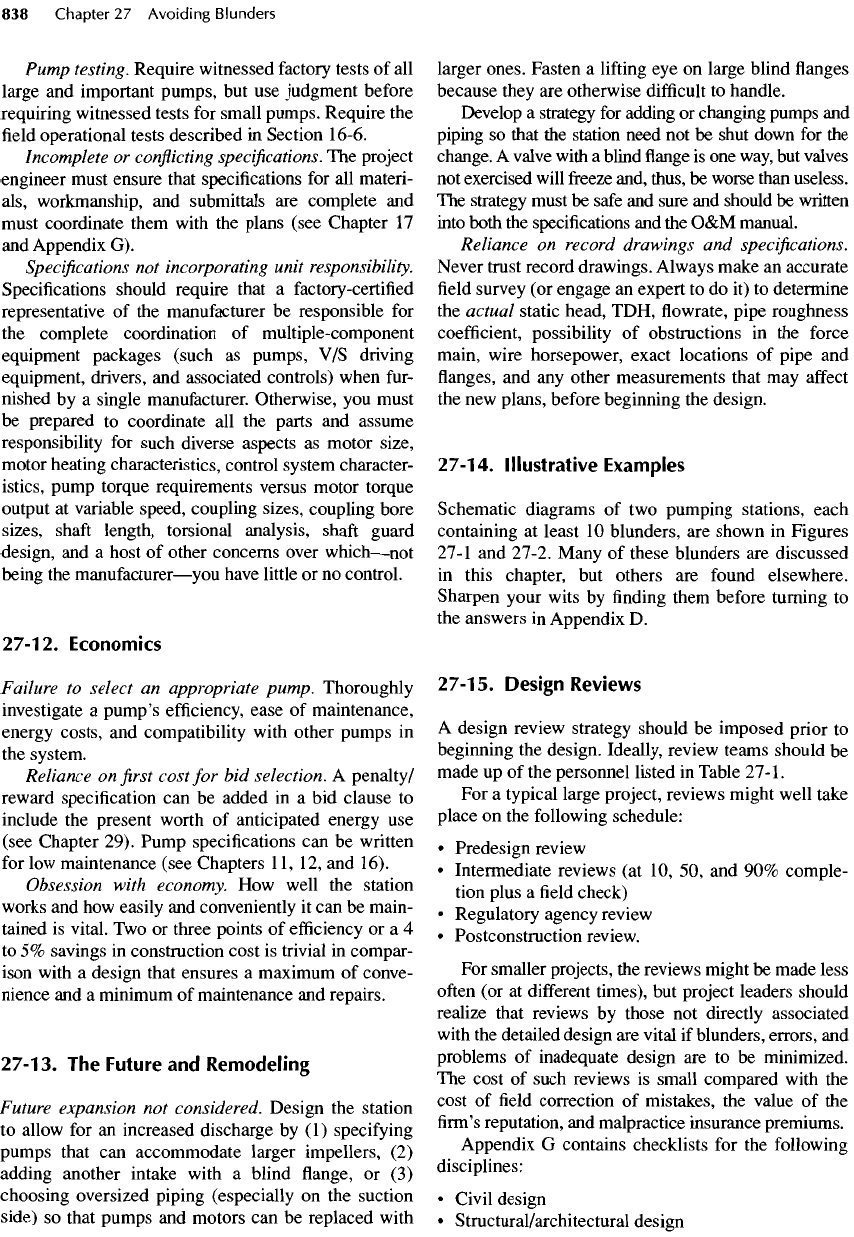
Pump
testing. Require witnessed factory tests
of all
large
and
important pumps,
but use
judgment before
requiring witnessed tests
for
small pumps. Require
the
field
operational tests described
in
Section 16-6.
Incomplete
or
conflicting
specifications.
The
project
engineer must ensure that specifications
for all
materi-
als,
workmanship,
and
submittals
are
complete
and
must
coordinate them with
the
plans (see Chapter
17
and
Appendix
G).
Specifications
not
incorporating
unit
responsibility.
Specifications
should require that
a
factory-certified
representative
of the
manufacturer
be
responsible
for
the
complete coordination
of
multiple-component
equipment packages (such
as
pumps,
V/S
driving
equipment, drivers,
and
associated controls) when fur-
nished
by a
single manufacturer. Otherwise,
you
must
be
prepared
to
coordinate
all the
parts
and
assume
responsibility
for
such diverse aspects
as
motor size,
motor
heating characteristics, control system character-
istics,
pump torque requirements versus motor torque
output
at
variable speed, coupling sizes, coupling bore
sizes,
shaft
length, torsional analysis,
shaft
guard
design,
and a
host
of
other concerns over
which
—
not
being
the
manufacturer
—
you
have little
or no
control.
27-12.
Economics
Failure
to
select
an
appropriate
pump.
Thoroughly
investigate
a
pump's
efficiency,
ease
of
maintenance,
energy
costs,
and
compatibility with other pumps
in
the
system.
Reliance
on first
cost
for bid
selection.
A
penalty/
reward
specification
can be
added
in a bid
clause
to
include
the
present worth
of
anticipated energy
use
(see Chapter 29). Pump specifications
can be
written
for
low
maintenance (see Chapters
11,
12, and
16).
Obsession
with
economy.
How
well
the
station
works
and how
easily
and
conveniently
it can be
main-
tained
is
vital.
Two or
three points
of
efficiency
or a 4
to 5%
savings
in
construction cost
is
trivial
in
compar-
ison
with
a
design that ensures
a
maximum
of
conve-
nience
and a
minimum
of
maintenance
and
repairs.
27-13.
The
Future
and
Remodeling
Future
expansion
not
considered. Design
the
station
to
allow
for an
increased discharge
by (1)
specifying
pumps that
can
accommodate larger impellers,
(2)
adding another intake with
a
blind
flange, or (3)
choosing oversized piping
(especially
on the
suction
side)
so
that pumps
and
motors
can be
replaced with
larger ones.
Fasten
a
lifting
eye on
large blind
flanges
because they
are
otherwise
difficult
to
handle.
Develop
a
strategy
for
adding
or
changing pumps
and
piping
so
that
the
station need
not be
shut down
for the
change.
A
valve with
a
blind
flange is one
way,
but
valves
not
exercised will
freeze
and, thus,
be
worse than useless.
The
strategy must
be
safe
and
sure
and
should
be
written
into both
the
specifications
and the O&M
manual.
Reliance
on
record
drawings
and
specifications.
Never trust
record
drawings. Always make
an
accurate
field
survey
(or
engage
an
expert
to do it) to
determine
the
actual static head, TDH,
flowrate,
pipe roughness
coefficient,
possibility
of
obstructions
in the
force
main, wire horsepower, exact
locations
of
pipe
and
flanges, and any
other measurements that
may
affect
the new
plans, before beginning
the
design.
27-14.
Illustrative
Examples
Schematic diagrams
of two
pumping stations, each
containing
at
least
10
blunders,
are
shown
in
Figures
27-1
and
27-2. Many
of
these blunders
are
discussed
in
this chapter,
but
others
are
found
elsewhere.
Sharpen your wits
by finding
them before turning
to
the
answers
in
Appendix
D.
27-15.
Design Reviews
A
design review strategy should
be
imposed prior
to
beginning
the
design. Ideally, review teams should
be
made
up of the
personnel
listed
in
Table
27-1
.
For a
typical large project, reviews might well take
place
on the
following schedule:
•
Predesign
review
•
Intermediate reviews
(at 10, 50, and 90%
comple-
tion plus
a field
check)
•
Regulatory agency review
•
Postconstruction
review.
For
smaller projects,
the
reviews might
be
made
less
often
(or at
different
times),
but
project leaders should
realize that reviews
by
those
not
directly associated
with
the
detailed
design
are
vital
if
blunders,
errors,
and
problems
of
inadequate design
are to be
minimized.
The
cost
of
such reviews
is
small compared with
the
cost
of field
correction
of
mistakes,
the
value
of the
firm's
reputation,
and
malpractice insurance premiums.
Appendix
G
contains checklists
for the
following
disciplines:
•
Civil design
•
Structural/architectural design
